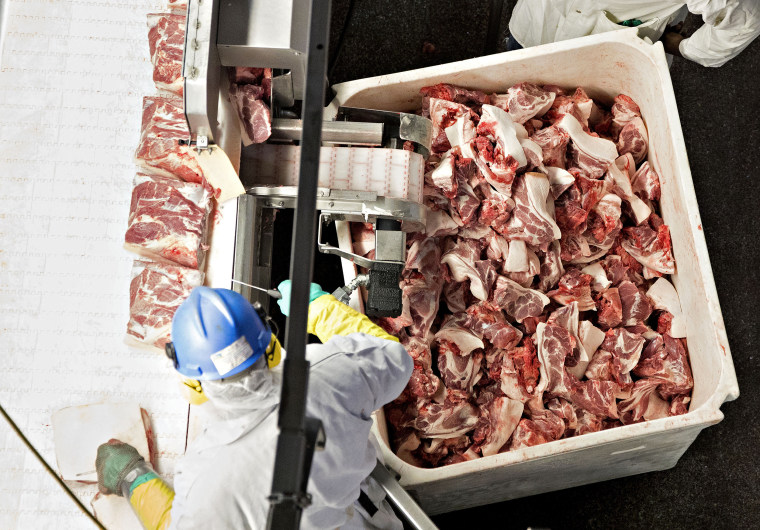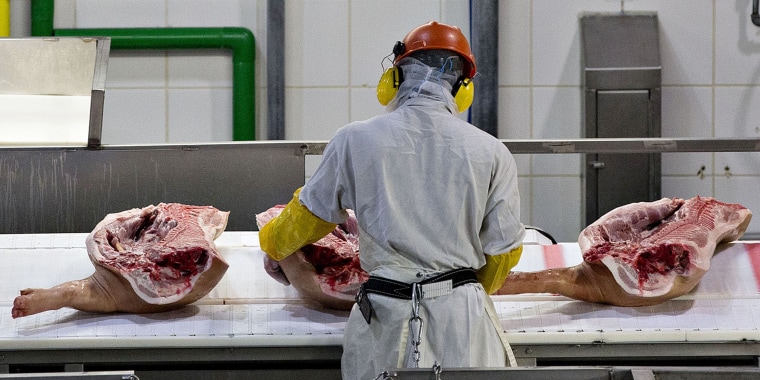Under new guidelines recently published by the U.S. Department of Agriculture, companies that manufacture pork products will soon have more control over how their hogs are sorted and presented to USDA inspectors. The guidelines also lift restrictions on how many hogs these facilities are allowed to process every hour.
While many big food producers are cheering, some food safety advocates, scientists and consumer groups fear the changes will be dangerous for both buyers and factory workers.
Twenty-two years ago, the USDA launched a pilot program in five pork processing plants. In these production plants, limitations on line speeds (i.e., how quickly pigs were slaughtered and processed per day) were lifted. The program also allowed companies to train employees to work alongside federal Food Safety Inspection Service inspectors to monitor the slaughtering process.

On Friday, FSIS public affairs specialist Veronika Pfaeffle confirmed to TODAY Food that this pilot program (known as HACCP-Based Inspection Models Project, or HIMP) is now set to roll out nationally. According to the FSIS spokesperson, the rule will "become effective 60 days from the date of publication in the Federal Register," which has not yet occurred. Once the rule is confirmed, however, both larger companies with 500 or more employees, and smaller ones with fewer than 10 employees, will have six months to decide whether to adapt the new regulations. Those companies must inform the USDA of their decision before enacting any changes.
The new regulation, now known as the New Swine Slaughter Inspection System, or NSIS, is comprised of two parts. Pfaeffle sent TODAY a FSIS Swine Modernization document that explained government inspectors will still inspect the meat ante-mortem (before death) and post-mortem (after death), but now company employees will be able to remove meat (or parts of meat) with certain defects from the inspection line while being monitored by federal inspectors. If federal inspectors find that a plant's employee continuously misses defects, "they will take appropriate action such as stopping the production line, issuing noncompliance record, and directing the establishment to reduce the line speed."
Although the new NSIS system is optional, FSIS predicts all 35 U.S. plants which are eligible will make the switch at some point, meaning there will be fewer federal inspectors working in the processing lines — but not by many, as the USDA estimates "the total reduction in FSIS inspectors would be less than 2 percent."
Plants under traditional regulations process between 571 to 1,149 pigs per hour daily, with an average of 977 animals processed per hour. Pfaeffle told TODAY that the average rate among plants exercising the NSIS pilot program is 1,099 heads per hour (hph), and varies between 885 to 1,295 hph.
Despite the FSIS' stated mission to modernize the way pork is processed, food safety advocates, consumer groups, as well as FSIS' former Chief Public Health Veterinarian Dr. Pat Basu have stated they are staunchly against NSIS for several reasons.
"(Modernization) has nothing to do with removing qualified and trained FSIS Inspection Program Personnel from critical duties, required under the law, and replacing them with unqualified and untrained minimum-wage plant employees, and then allowing these plants to run their slaughter lines at any line speed," Basu told TODAY.
Basu, who has since founded his own food safety consultancy, added, "The changes proposed by FSIS to create the New Swine Inspection System is not the definition of 'modernization,' it is the definition of a public health, food safety, and an economic disaster for all United States citizens and the consumers of U.S. product exported worldwide."
Consumer Reports senior scientist Michael Hansen agreed with Basu.
"It's problematic," Hansen TODAY. "We have opposed the NSIS, which reduces the number of federal inspectors ... Instead, we think the USDA should use evidence-based reforms to improve food safety, such as by requiring microbial testing for pathogens such as salmonella, yersinia enterolitica ... E. coli and Staphylococcus aureus." He added that the agency should also be "setting pathogen reduction standards for these products in pork and pork products."
Wenonah Hauter, executive director of consumer advocacy group Food & Water Watch, has suggested that company employees being responsible for checking meat under speedier deadlines will make it far more likely for things to slip through the cracks and therefore raise the potential for more foodborne illnesses to spread, Reuters reported. The group also believes faster lines may cause more harm to employees operating dangerous machinery.
Food & Water Watch requested food safety data from the USDA under the Freedom of Information Act for the five HIMP plants between January 2012 and November 2016.
"Over the five-year period, there were 32 instances — all occurring in the HIMP plants — in which a USDA on-line inspector discovered that a plant employee failed to identify a carcass so infected that consumption of the meat could cause food poisoning," the review stated.
Overall, Food & Water Watch found that the five pilot program plants received fewer non-compliance reports than five plants under the traditional system. However, the pilot program plants accounted for 84% of the non-compliance reports related to food safety specifically.
Despite the critics, Pfaeffle defended the new regulations, stating that even when the pilot program plants did increase line speeds, there were some beneficial results, such as "lower levels of non-food safety defects" and "equivalent or better Salmonella verification testing positive rates."
"In other words, even when they were allowed to run as fast as they want, they didn’t and ran only a little faster than plants operating under traditional inspection," Pfaeffle told TODAY. "Again this idea that they would run hog wild is not based on data or in reality."
Basu, who worked with the FSIS for 36 years, reviewed data in 2016 that he says shows a different story.
"The data showed significant public health-related deficiencies in all the pilot plants," he said. "My conclusion demonstrated that almost none of the five pilot plants were in compliance with FSIS regulations."
Up until his retirement in January 2018, Basu fought the NSIS from being rolled out as a national program. Less than a month after Basu left the USDA, an announcement about the rule was published in the Federal Register, allowing the USDA to receive public feedback on the NSIS.
In response to Basu's evaluation, Pfaeffle said, "Those five plants represent 15% of the U.S. pork supply. They have been operating since 1997. In short if you, a family member or a friend has eaten bacon, sausage, pork chops, etc. in the last 20 years, you have eaten products produced under this inspection system."
Editor's note: An earlier version of this story incorrectly stated that under the HACCP-Based Inspection Models Project pilot program, pork processing plants had the option to chose whether company employees or USDA workers inspected hogs. USDA employees have always been legally required to be involved in the hog inspection process. At the time of this story's publication, the final NSIS rule has not been published in the Federal Register.



